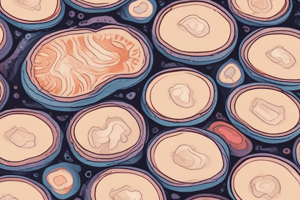Podcast
Questions and Answers
What type of medium is typically used to identify gram negative Enterobacteriaceae?
What type of medium is typically used to identify gram negative Enterobacteriaceae?
- Mannitol Salt Agar
- MacConkey Agar (correct)
- Nutrient Agar
- Blood Agar
What is a common characteristic of non-lactose fermenting Enterobacteriaceae members found on MacConkey agar?
What is a common characteristic of non-lactose fermenting Enterobacteriaceae members found on MacConkey agar?
- Yellow colonies
- Colorless colonies (correct)
- Green colonies
- Pink colonies
Which of the following features is critical for the identification of lactose-fermenting coliforms in the Enterobacteriaceae family?
Which of the following features is critical for the identification of lactose-fermenting coliforms in the Enterobacteriaceae family?
- Production of urease
- Formation of colored colonies on selective media (correct)
- Ability to produce hydrogen sulfide
- Resistance to bile salts
Flashcards
Gram Negative Enterobacteriaceae Identification
Gram Negative Enterobacteriaceae Identification
A method used to distinguish gram-negative bacteria of the Enterobacteriaceae family.
Identification Medium
Identification Medium
A specific substance or environment used to differentiate bacteria based on their characteristics.
Gram negative
Gram negative
A bacterial characteristic involving a specific staining reaction; in this context, the bacteria will not retain the crystal violet stain during the procedure.
Enterobacteriaceae
Enterobacteriaceae
Signup and view all the flashcards
Bacterial Differentiation
Bacterial Differentiation
Signup and view all the flashcards
Lactose-fermenting coliforms
Lactose-fermenting coliforms
Signup and view all the flashcards
Enterobacteriaceae identification medium
Enterobacteriaceae identification medium
Signup and view all the flashcards
What medium differentiates coliforms?
What medium differentiates coliforms?
Signup and view all the flashcards
How does the medium work?
How does the medium work?
Signup and view all the flashcards
Why is this important?
Why is this important?
Signup and view all the flashcards
Enterobacteriaceae Identification
Enterobacteriaceae Identification
Signup and view all the flashcards
Media for Identification
Media for Identification
Signup and view all the flashcards
Differential Media
Differential Media
Signup and view all the flashcards
How do coliforms change media?
How do coliforms change media?
Signup and view all the flashcards
Study Notes
Culture Media for Gram-Negative Enterobacteriaceae Identification
-
MacConkey agar: A selective and differential medium used for the isolation and presumptive identification of Gram-negative bacteria, particularly Enterobacteriaceae.
- Selective: The bile salts and crystal violet in MacConkey agar inhibit the growth of many Gram-positive bacteria.
- Differential: It differentiates bacteria based on their ability to ferment lactose.
- Lactose fermenters appear as pink or red colonies due to the production of acid.
- Non-lactose fermenters appear as colorless or translucent colonies.
- Important Note: While MacConkey agar is useful for initial screening, further tests are typically needed for definitive identification, as other Gram-negative bacteria besides Enterobacteriaceae can also grow on it.
-
Eosin-Methylene Blue (EMB) agar: Another selective and differential medium suitable for isolating and preliminary identifying Gram-negative bacteria, including Enterobacteriaceae.
- Selective: EMB agar inhibits the growth of Gram-positive bacteria, and some Gram-negative bacteria.
- Differential: Similar to MacConkey, it differentiates based on the ability to ferment lactose.
- Strong lactose fermenters often produce dark purple or black colonies with metallic green sheen due to the accumulation of acid and dyes.
- Weak lactose fermenters have a lighter appearance.
- Non-lactose fermenters appear colorless.
- Usefulness: It helps distinguish between lactose fermenting and non-fermenting bacteria, like the Enterobacteriaceae. However, further testing is usually necessary to identify specific species.
-
Xylose-Lysine-Deoxycholate (XLD) agar: A selective and differential medium specifically designed for the isolation and screening of Enterobacteriaceae.
- Selective: The deoxycholate salt inhibits the growth of many Gram-positive bacteria and some Gram-negative organisms.
- Specific Differential: The Xylose-Lysine-Deoxycholate (XLD) medium is particularly helpful in identifying bacteria based on their reactions to various sugars like xylose, with differential reactions visible due to color changes.
- Bacteria capable of fermenting xylose or lysine will appear as yellow colonies with a black center or surrounded by black precipitate.
- Other colonies are sometimes differentiated by color and shape.
- Notable use: This medium is valuable because the black precipitate or discoloration often indicates the presence of specific metabolic byproducts (e.g., hydrogen sulfide).
-
Other special media: Depending on the suspected species and the specific identification protocol being employed, additional media may be required. These may include media designed for detecting specific metabolic products (e.g., hydrogen sulfide production) or for testing the fermentation of various carbohydrates.
Additional Considerations
- Biochemical tests: After initial isolation on selective media, biochemical tests are needed to confirm the final identification of Enterobacteriaceae.
- Examples: Tests for oxidase, catalase, fermentation of specific sugars, motility (using motility agar), and reactions to specific acids. The results of these tests are then analyzed for a species-specific profile.
- Microscopic examination: Gram staining is an essential initial step to confirm the presence of Gram-negative bacteria.
- Colony morphology: The appearance of bacterial colonies on the respective media can aid in early identification but needs further testing.
Significance of Media Choice
- Identifying the correct medium is a crucial step in isolating and identifying Enterobacteriaceae accurately.
- The specific medium chosen depends on the suspected pathogen and the aims of the tests.
- Ideally, a combination of media with complementary selective and differential properties are used, followed by subsequent biochemical tests to reduce the possibility of misidentifications.
Studying That Suits You
Use AI to generate personalized quizzes and flashcards to suit your learning preferences.




